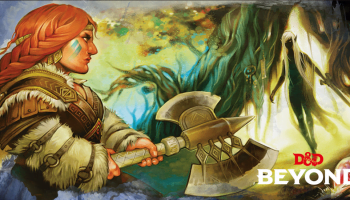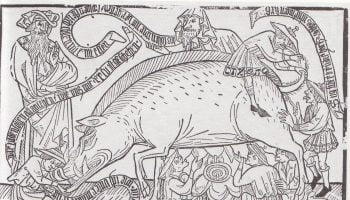This is Part IV of The Public Medievalist’s continuing series on Race, Racism and the Middle Ages.
Read the Introduction to the our series here, Part I, here, Part II here, and Part III here.
The prior articles in this series by Dr DarkAge and James Harland revealed a question that we have yet to address but which needs to be asked: what does “race” actually mean? What is “race”?
Many people today think of race (and its cousin “ethnicity”) in quite simplistic terms; people have different attributes (skin color, eye shape, hair color and texture, ancestral origin etc.) that leads to being divided into broad categories. Those broad categories roughly correspond with an imagined ancestral homeland. But while those categories may seem natural or normal, they are fundamentally arbitrary. Drawing stark lines between peoples is impossible; the shades and shapes of humanity form a spectrum of variance. Race, simply put, is not real.
Wait, What?
The idea of race is so powerful within our culture that calling it a myth may seem insane. But those who study human diversity the most have known this simple truth for over sixty years. As Robert Wald Sussman puts it in his book The Myth of Race: The Troubling Persistence of an Unscientific Idea:
In 1950, UNESCO issued a statement asserting that all humans belong to the same species and that “race” is not a biological reality but a myth. This was a summary of the findings of an international panel of anthropologists, geneticists, sociologists, and psychologists. A great deal of evidence had been accumulated by that time to support this conclusion, and the scientists involved were those who were conducting research and were most knowledgeable about the topic of human variation. Since that time […] an enormous amount of modern scientific data has been gathered to justify this conclusion. Today the vast majority of those involved in research on human variation would agree that biological races do not exist among humans. Among those who study the subject, who use and accept modern scientific techniques and logic, this scientific fact is as valid and true as the fact that the earth is round and revolves around the sun.
Basically, racists are little better than flat-earthers.
But let’s step back a moment. Of course there are genetic differences between people and among groups. These can have serious consequences on your life, even your health. But, as Carol C. Mukhopadhyay writes in her book How Real is Race? A Sourcebook on Race, Culture, and Biology, things are not so simple as we have been led to believe:
Anthropologists aren’t arguing that there is no biological component in U.S. racial categories. Biology has played a role in the cultural invention of what we call race […] And race, or rather, one’s racial designation, socially, can have enormous biological consequences, including on one’s health status. But most of what we believe or have been taught about race as biology, as valid subdivisions of the human species, and an important part of human biological variation is a myth.
We can send away a cheek swab to test our genetic makeup, and receive a report tracing markers originating in different parts of the world. We can see differences between ourselves and our peers, and note their height or hair or skin. But what—if anything—do those differences mean?
All the problems arise when meaning is made from these superficial genetic differences. It’s a fairly short leap to the incorrect conclusion that peoples, in addition to their similar surface-level physical attributes, might have different psychological, physical, or intellectual attributes. It’s such a pervasive, simple idea that it can lead us to believe that it’s actually true, normal, or natural. It’s a powerful idea, one that, in many ways, we have structured our society around. This is so true that after sixty years of scholarship which says over, and over, and over that it is not true, this simple idea may still be shocking.
“Race” and Racist Inductive Reasoning
The logic of race may seem sound at first glance. For example, runners from sub-Saharan Africa often dominate track categories in the Olympics, and African Americans dominate the NBA and NFL. By inductive reasoning, therefore, black people must naturally make better athletes. And since white people dominate business, academia, and politics in the U.S. and Europe, surely that is because they have some innate abilities in those arenas. But inductive reasoning like this is flatly incorrect; when you begin to examine the idea of race—and the meanings that are made from it more closely, the whole thing quickly unravels.
Scientists, sociologist and psychologists have found that there are no behavioral or intellectual differences whatsoever between peoples based on race or ethnicity that cannot be attributed to other—typically social—factors, or good old individual variation. Africans dominate running in the Olympics because of cultural factors, not biological ones. Chief among the factors that determine people’s circumstances are those affected by social, institutional and structural racism—which explains why white people dominate business, academia, and politics in the U.S. and Europe. Sussman continues:
Racism is a part of our everyday lives. Where you live, where you go to school, your job, your profession, who you interact with, how people interact with you, your treatment in the healthcare and justice systems are all affected by your race.
Dr. DarkAge discussed previously that the white-supremacist self-described “alt-right” argues that it is simply engaging in “racialism”—neutrally describing the differences among races—rather than “racism”. But racialism and racism are simply the same. Mukhopadhyay puts it simply:
It [the idea of “race”] emerged in a context of unequal power relations, as an ideology to legitimize the dominance of certain groups. Race, then, is fundamentally part of a system of stratification and inequality.
The Medieval Context of “Race”
Because of the fact that “race” is an invented socio-cultural construct, it is perhaps unsurprising that medieval people had a fundamentally different understanding of “race”. We will be exploring this in more detail over the course of this series. But as we do, it is important to remember that unlike the germ theory of disease or the theories of relativity, the difference between medieval and modern conceptions of race exist not because humanity is reaching towards a better understanding of reality. It is because we have built for ourselves a convenient mythology that serves to justify the state of the world, and to relabel injustice as the natural order of things.

So, when thinking about the idea of race in the Middle Ages, it is critical to remember that we are discussing a mythology no more real than fairies. As James Harland wrote last week, it is a “situational construct”: even though it is imagined, it is not imaginary. Because people imbue this imagined construct with meaning (and codify it into law, religion, and all facets of life), it has profound real-world effects. The idea of race is like an evil version of Tinkerbell; it is only real because people believe in it—but because they do, it makes everyone’s lives hell.
For Further Reading
Don’t believe me? Don’t take my word for it. If you want to learn more about the myth of race, read any of these excellent books on the topic:
How Real Is Race?: A Sourcebook on Race, Culture, and Biology, by Carol C. Mukhopadhyay, Rosemary Henze, Yolanda T. Moses
The Myth of Race: The Troubling Persistence of an Unscientific Idea, by Robert Wald Sussman
The Nature of Race: How Scientists Think and Teach about Human Difference, by Ann Morning
Race?: Debunking a Scientific Myth, by Ian Tattersall, Rob DeSalle
The Race Myth: Why We Pretend Race Exists in America, by Joseph L. Graves
Continue to Part V of our Series: To Russia, With Love: Courting A New Crusade
The Public Medievalist does not pay to promote these articles, so we would love it if you shared this with your history-loving friends! Click to share with your friends on Facebook, or Twitter.





Comments are closed.